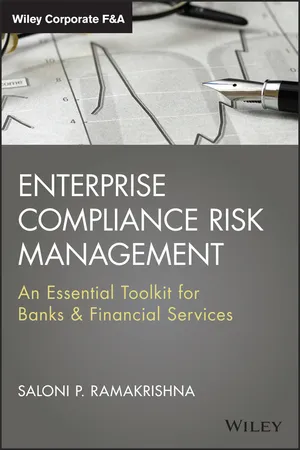
Enterprise Compliance Risk Management
An Essential Toolkit for Banks and Financial Services
- English
- ePUB (mobile friendly)
- Available on iOS & Android
Enterprise Compliance Risk Management
An Essential Toolkit for Banks and Financial Services
About This Book
The tools and information that build effective compliance programs
Enterprise Compliance Risk Management: An Essential Toolkit for Banks and Financial Services is a comprehensive narrative on managing compliance and compliance risk that enables value creation for financial services firms. Compliance risk management, a young, evolving yet intricate discipline, is occupying center stage owing to the interplay between the ever increasing complexity of financial services and the environmental effort to rein it in. The book examines the various facets of this layered and nuanced subject.
Enterprise Compliance Risk Management elevates the context of compliance from its current reactive stance to how a proactive strategy can create a clear differentiator in a largely undifferentiated market and become a powerful competitive weapon for organizations. It presents a strong case as to why it makes immense business sense to weave active compliance into business model and strategy through an objective view of the cost benefit analysis.
Written from a real-world perspective, the book moves the conversation from mere evangelizing to the operationalizing a positive and active compliance management program in financial services. The book is relevant to the different stakeholders of the compliance universe - financial services firms, regulators, industry bodies, consultants, customers and compliance professionals owing to its coverage of the varied aspects of compliance.
Enterprise Compliance Risk Management includes a direct examination of compliance risk, including identification, measurement, mitigation, monitoring, remediation, and regulatory dialogue. With unique hands-on tools including processes, templates, checklists, models, formats and scorecards, the book provides the essential toolkit required by the practitioners to jumpstart their compliance initiatives. Financial services professionals seeking a handle on this vital and growing discipline can find the information they need in Enterprise Compliance Risk Management.
Frequently asked questions
Part One
Introduction to Compliance in Financial Services
Practitioner's Note: The umbilical cord between business model and compliance
Chapter 1
An Overview of Compliance in Financial Services
“Money plays the largest part in determining the course of history.”
- The emergence of financial conglomerates that are growing both in size and numbers
- Bank, insurance, and market intermediary linkages that are becoming commonplace
- Abolition of barriers/restrictions on investment/commercial banking combinations2
Table of contents
- Cover
- Advance Praise
- Title Page
- Copyright
- Table of Contents
- Dedication
- Preface
- Acknowledgments
- About the Author
- Opening Notes
- Design and Structure of the Book
- Part One: Introduction to Compliance in Financial Services
- Part Two: The What, Why, and Who of Compliance
- Part Three: The How of Compliance
- Part Four: The Compliance Risk Dimension
- Part Five: The Real World of Compliance in Financial Services
- Closing Notes
- Index
- End User License Agreement